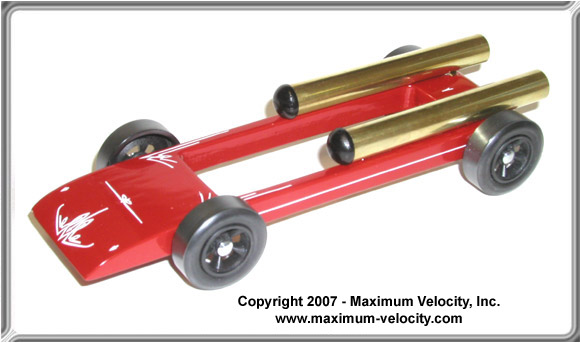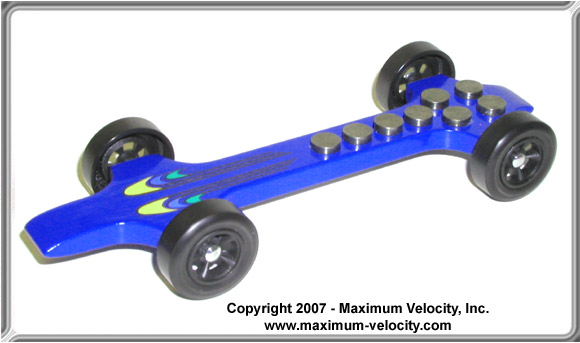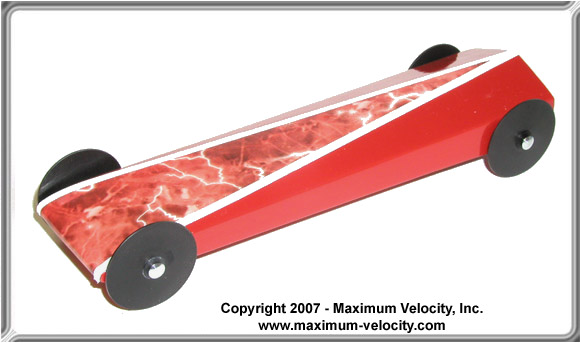– Feature Article – Rail Riding
– Pinewood Derby Car Showcase
– Memory – My Three Sons
– Q&A
Rail Riding
One of the five keys to performance1 is alignment. The purpose of alignment is to adjust the steering of the car such that the car rolls in the desired direction.
But what is the desired direction? The seemingly apparent answer is “straight”, and that was the answer I would have given in the past. But does straight alignment really produce the best performance?
Nothing Is Perfect
The answer is no (this will be proven experimentally later in this article). If the track was perfectly level and smooth (no deviations whatsoever), and if the car could be set perfectly straight (again no deviations), then clearly, straight alignment would be the best. But a perfect track is an impossibility (most tracks are far from level and smooth), and in fact, perfectly straight alignment is not possible. So, what happens if a car that rolls reasonably straight is raced on a track that is not perfect? It will exhibit one of the following behaviors:
- Track generally tilts left – Car will roll until the right wheels contact the center guide rail, and will generally stay there for the entire run.
- Track generally tilts right – Car will roll until the left wheels contact the center guide rail, and will generally stay there for the entire run.
- Track tilts both left and right – Car will oscillate between contacting the left and right wheels.
Now let’s add one other factor: a raised wheel. The purpose of the raised front wheel is to reduce the energy required to start the wheels rolling. If the raised wheel can be prevented from spinning, an advantage will be gained. But if the raised wheel contacts the guide rail, even one time, the advantage will be lost.
So what can you do to get the best performance within the limitations of the track and the car’s alignment? The answer is: create a Rail-Rider™ car.
Rail-Riding
To get the best performance under non-perfect conditions, we must minimize the number of wheels that contact the guide rail, and ensure that the raised wheel does not contact the guide rail. Thus, the alignment of the front dominant wheel must be adjusted so that it steers towards the raised wheel (thus keeping the raised wheel away from the center guide rail). So, if the front-left wheel is raised, then the front-right wheel is adjusted so that the car drifts to the left. If the back wheels are aligned straight, then the front right wheel will be the only wheel that contacts the guide rail.2 Thus, the front-right wheel, more or less, rides the rail down the track.
Experiment
This discussion is all academic, so let’s set about proving whether or not rail-riding really provides the intended benefit.
Equipment
First, we must create a car with a front-right wheel with a toe-in/toe-out adjustment. This allows the car’s drift to be adjusted without removing the axle, thus minimizing experimental variance.
The toe-in/toe-out adjustment was accomplished using set screws. Aluminum tubing was used to hold the axle and provide a pivot point (see Figure 1).
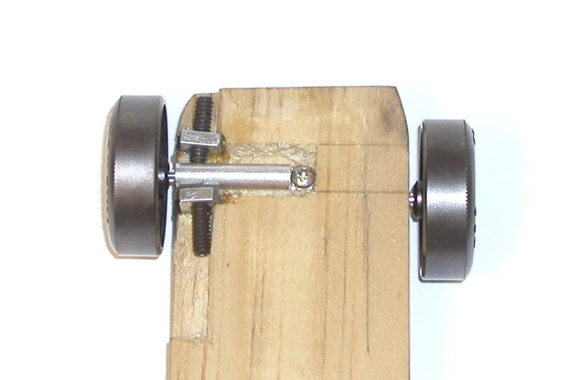
Additional equipment includes:
- 32 Foot Aluminum Freedom Track, the track was leveled with a bubble level and shims.
- Rear weighted extended wheelbase wedge weighing five ounces, front- left wheel raised
- Krytox 100 Lube3
- Pro Stock Speed Wheels from DerbyWorx
- Speed Axles from Maximum Velocity
Procedure
Six heats were run, each with six different toe-in/toe-out settings.4 The inches of deviation is the amount of drift over an 8 foot run on an alignment board.
- 5 inches left
- 3 inches left
- Center alignment
- 3 inches right
- 5 inches right
After the heats were run, the high and low times were removed and the remaining heats averaged.
Results
The results of the experiment are shown in Figure 2.
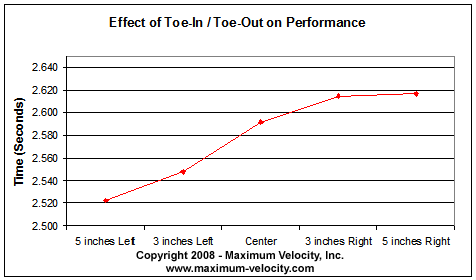
Conclusions
The experiment clearly proves the benefit of rail-riding. For this experimental setup, a drift of up to 5 inches (and probably more) provides an incremental performance benefit. But, please note that the aluminum track on which this test was performed has a very smooth center guide rail. On other tracks, especially wooden tracks, the best amount of drift would need to be experimentally determined. A rougher center guide rail may require a lesser amount of drift.
1See Pinewood Derby Times, Volume 15, Issue 1 – Five Keys to Performance.
2To further ensure that the back-right wheel does not contact the guide rail, the front right of the car can be narrowed slightly such that the front- right wheel runs slightly closer to the guide rail than the back-right wheel.
3During this experiment, no graphite was used. However, the same car was used for a later experiment which used graphite. The photo in Figure 1 was taken after the second experiment, so graphite can be seen on the tread surface of the wheel.
4I would have liked to have had finer settings, but the threads on the set screws were too coarse to readily allow a finer adjustment. I also would have liked to have tried a larger left drift, but my alignment board was not wide enough to go further.
™Rail-Rider is a trademark of DerbyWorx / Warp Speed, Inc.
Car Showcase
We are almost out of showcase cars, so I thought I would share our 2007 cars (not shown is the original prototype of the Velocinator, which was included in Volume 7, Issue 4).
Speeder: Stephen Davis
My youngest son, Stephen, has always liked the Speeder (I do too). This is the second Speeder he has made (the first was in 2002). It was quite fast, taking 3rd place, but not fast enough to catch his sister’s 1st Place car.
Detonator: Janel Davis
My youngest daughter built this Detonator. It was extremely fast, easily taking first place.
Wedge SE: Elisa Davis
The extended wheelbase Wedge SE is weighted with tungsten, and is equipped with Outlaw wheels. It was nosed into 2nd Place, behind an extended wheelbase Bolt equipped with Outlaw wheels (built in our shop by a friend).
Pinewood Derby Memory
My Three Sons
As a Cubmaster with three boys in Cub Scouts, I didn’t know anything about pinewood derby racing when I first started. But I always believed in my sons doing as much work as they safely could. They would do about ninety percent of the work with me by their side helping them, or they watching what I was doing. I always believed in the “Do your Best” motto. More importantly was that they were happy with the way the car looked. I would suggest that they do a little more sanding, or touch up the paint, but only if they wanted to do it.
The best my oldest son did was about 10th place. I learned how to build fast cars with him.
My middle son came in first place two years in a row. At the end of the race he was hearing some comments from his buddies like, “I bet next year he’ll win again”. So when the next year came, I suggested we do something different and not worry about speed. He agreed. So when the next race came we made a great looking hot dog on a bun. Talk about NOT being stream lined. Well, he came in fourth place in the race and won “Best of Show”.
Now my youngest son, who is a Webelos 1, knows what he wants. He wants low, slick, and fast; and he has come in first or second place every year. But, the best thing is that we have fun together and learn from each other.
Bill Whittaker
Q&A
Do you recommend jewelry polish for axles? I think it is called rouge. How do you use it?
Jeweler’s Rouge is a polish that can be used on axles. Red jeweler’s rouge (which is iron oxide) is the most common variety. It generally comes in a bar which is somewhat brittle.
To use it, rub a damp cloth on the rouge bar. Then apply the damp rouge to a spinning axle. Make sure to buff off the axle with a clean, dry rag. Then lubricate as usual.
When using NyOil II or powdered graphite how do you apply once the axles are glued into place? I’ve read about gluing axles with hot glue, etc. so it seems that this would be difficult to accomplish once the axles are set in the body.
I recommend lubricating before the wheels/axles are mounted on the car. Generally, you do not relube during a race.
If the car could progress to a future championship race event, then glue the axles with white glue. This will hold them in place, but the glue bond can be easily broken for axle removal. Then clean, lube, and remount before the next race event.
Want Answers?
Do you have a pinewood derby-related question? If so, e-mail us your question.We answer all questions by e-mail, but not every question will appear in the Q&A section of the newsletter.
Back Issues
Are you a new subscriber, or have you missed some of the previous newsletters? Don’t miss out; all of the issues for Volume 5 through Volume 17 are posted on our web site.
Newsletter Contributions
We welcome your contributions. If you would like to contribute an article, a web site review, a speed tip, or a pinewood derby memory, please e-mail us.
Subscription Information
The Pinewood Derby Times is a free e-newsletter focused on pinewood derby racing. It is published biweekly from October through March.
If you haven’t already done so, please forward this issue to your pinewood derby friends. But please don’t subscribe your friends. Let them decide for themselves. Thanks.
If this newsletter was forwarded to you, why not subscribe to receive this newsletter. There is no cost, and your e-mail address is safe, as we never sell or share our distribution list.
To subscribe, send a blank e-mail to
pi*********************@*******st.com
You will receive a confirmation e-mail. Reply to the confirmation e-mail and you will start receiving the Pinewood Derby Times with the next issue.
Randy Davis, Editor, Pinewood Derby Times
E-Mail: in**@**************ty.com
(C)2018, Maximum Velocity, Inc. All rights reserved. Please do not reprint or place this newsletter on your web site without explicit permission. However, if you like this newsletter we grant permission, and encourage you to e-mail it to a friend.
Maximum Velocity disclaims any personal loss or liability caused by utilization of any information presented in this newsletter.
The Pinewood Derby Times is not specific to, and is not affiliated with the Boy Scouts of America, YMCA, Awana, or any other organization.
(R)Maximum Velocity is a registered trademark of Maximum Velocity, Inc.
(R)Pinewood Derby is a registered trademarks of the Boys Scouts of America.
(R)Awana is a registered trademark of Awana Clubs International.
All other names are trademarks of their respective owners.

